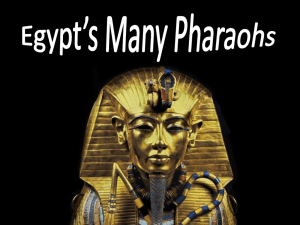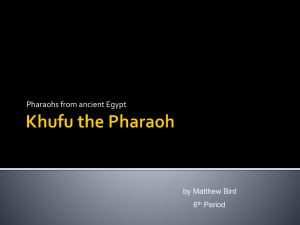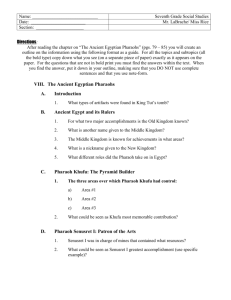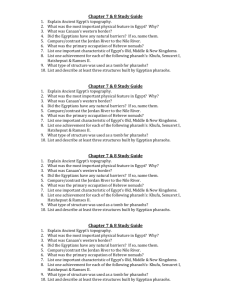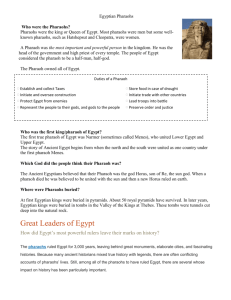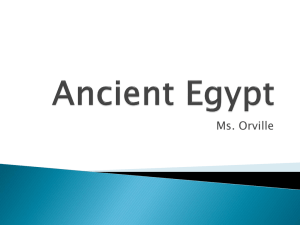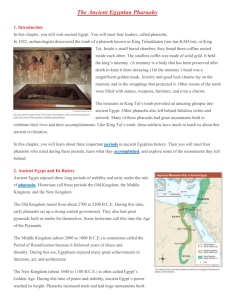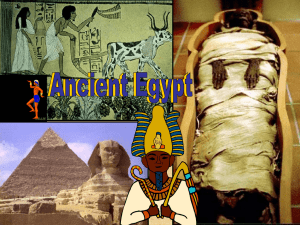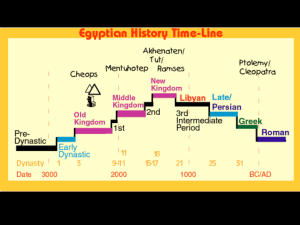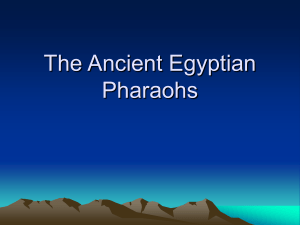Chapter 8 Anciet Egyptian Pharoahs
advertisement
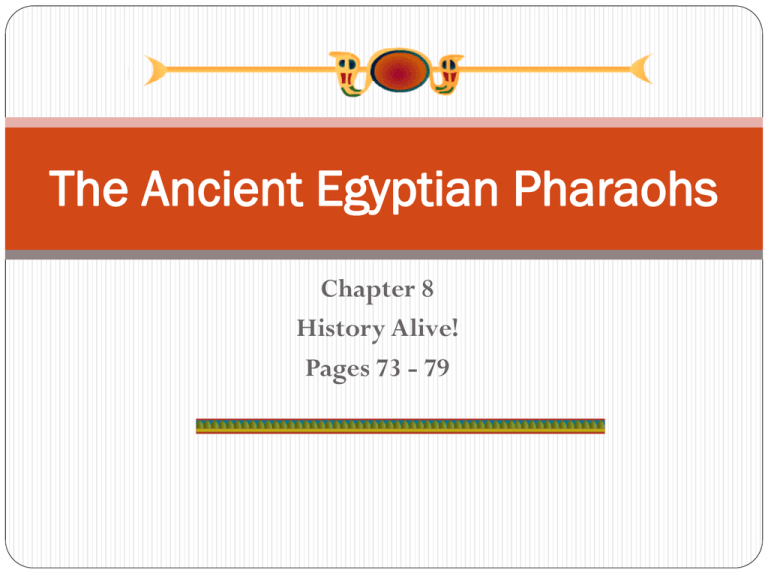
The Ancient Egyptian Pharaohs Chapter 8 History Alive! Pages 73 - 79 8.1 Introduction Pharaohs – leaders of ancient Egypt. In 1922, archeologists discovered the tomb of King Tutankhaten, or King Tut. Mummy – is a body that has been preserved after death to keep it from decaying. Tutankhaten’s tomb was filled with jewelry, good luck charms, weapons, furniture, statues and even a chariot. The treasures in his tomb provided an amazing glimpse into ancient Egypt. Many pharaohs built great monuments to celebrate their accomplishments. 8.2 Ancient Egypt and Its Rulers Ancient Egypt enjoyed three long periods of stability and unity under the rule of pharaohs. Historians call these periods the Old, Middle and New Kingdoms. During the Old Kingdom, pharaohs set up a strong central government. They also built great pyramids as tombs for themselves. Historians call this time the Age of Pyramids. During the Middle Kingdom, Egyptians made many great achievements in literature, art and architecture. Historians refer to the Middle Kingdom as the Period of Reunification because it followed years of chaos and disunity. During the New Kingdom, Egypt’s power reached its height. Pharaoh’s increased trade and built gigantic monuments. Historians refer to this time as Egypt’s Golden Age. 8.2 Ancient Egypt and Its Rulers (continued) Religion played a central role in Egypt’s social and political order. The pharaohs were believed to be gods. Pharaohs owned all the land and were responsible for all the people’s well-being. They were kings, generals and religious leaders all at once. After they died, the pharaohs were thought to enter an afterlife that would never end. Their great tombs were built to last forever! 8.3 Pharaoh Khufu: The Pyramid Builder The pharaoh Khufu ruled during the Old Kingdom. Today Khufu is known as the builder of the famous pyramid. Khufu emphasized his supreme power by declaring himself a god. He kept strict control over Egypt’s food supply. Khufu and other pharaohs during the Old Kingdom built pyramids as tombs for themselves and their families. The Great Pyramid of Giza was made with over 2 million stone blocks that fit together perfectly. Inside, tunnels led to several burial chambers. It took over 20 years to complete. It is the only remaining wonder of the ancient world. The pyramid was a stunning monument to Egyptian engineering. The Great Pyramid is located at the center of the land mass of the earth. The east/west parallel that crosses the most land and the north/south meridian that crosses the most land intersect in two places on the earth, one in the ocean and the other at the Great Pyramid. 8.4 Pharaoh Senusret I: Patron of the Arts The pharaoh ruled during the Middle Kingdom. Art, literature and architecture flourished during his reign. Craftspeople thrived under Senusret’s rule. He controlled mines loaded with gold, copper and gems. Some of the greatest works in Egyptian literature were written during Senusret’s reign. Senusret’s greatest accomplishments were in religious architecture. He built and improved many temples, shrines and religious monuments. Some historians think his White Chapel was his finest architectural achievement. The White Chapel was made of alabaster, a hard white stone. Senusret wanted his memory to live on through his monuments. But almost none of his buildings survived the passage of time. 8.5 Pharaoh Hatshepsut: Promoter of Egyptian Trade Hatshepsut was Egypt’s first female pharaoh. Never before had Egypt been ruled by a woman. Under her rule, art, architecture and trade flourished. One of Hatshepsut’s greatest accomplishments was simply gaining power. She demanded the same respect as a male ruler. Sometimes she wore men’s clothing including a fake beard. Artists were often instructed to portray her as a man. She spread stories that her father was a god. 8.6 Pharaoh Ramses II: Military Leader and Master Builder Called Ramses the Great, he is one of the most famous pharaohs. He reigned for more than 60 years, longer than almost any other pharaoh. He is best known for his military leadership and for building numerous monuments. He had hundreds of statues erected of himself all over Egypt. He was made captain in the Egyptian army at age 10. Ramses was a peacemaker. He signed the world’s first peace treaty. One of Ramses’ most impressive projects was the temple complex of Abu Simbel. 8.6 Pharaoh Ramses II: Military Leader and Master Builder (continued) Alongside the temple was a smaller temple honoring his favorite wife, Nefertari. Four giant seated statues of Ramses framed the entrance to the main temple. They are among the finest examples of Egyptian art. The temple was built so that twice a year the sun lined up with the entrance. Beams of sunlight would light up the statues. He built more temples and monuments than any other pharaoh in history. He is one of the best-preserved mummies ever found.
